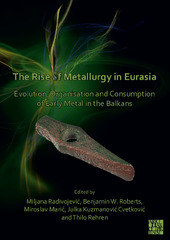Приказ основних података о документу
Ground and abrasive stone tools from Belovode and Pločnik: concluding remarks.
| dc.creator | Dimić, Vidan | |
| dc.creator | Antonović, Dragana | |
| dc.date.accessioned | 2023-11-23T10:30:25Z | |
| dc.date.available | 2023-11-23T10:30:25Z | |
| dc.date.issued | 2021 | |
| dc.identifier.isbn | 978-1-80327-042-5 | |
| dc.identifier.isbn | 978-1-80327-043-2 | |
| dc.identifier.uri | http://rai.ai.ac.rs/handle/123456789/823 | |
| dc.description.abstract | The Neolithic polished stone industry in Serbia appears as a fully developed operation, with clearly defined and formed types of tools; there is currently little evidence relating to its origins. An exception is the area of the Djerdap Gorge in northeastern Serbia, where the specificity of the populated area and immersion in different types of raw materials already in the Mesolithic, resulted in sedentary communities and the creation of an indigenous, totally unique industry of ground stone (Antonović 2003: 131, 142–143). In the rest of Serbia, it has not yet been possible to establish the beginning of the development of the polished stone industry. From the Early to the Late Neolithic in Serbia there is no substantial difference in processes, with tool types being the same for most of the raw materials, although there is some variation in the quantities of certain types of tools and materials depending upon the locality. The process for producing polished stone tools throughout the Neolithic remains utterly unchanged and the techniques used in the processing of raw materials to the finished tool are directly determined by the raw material used. Vinča craftspeople used various techniques, from primary flaking, retouching, and pecking, to grinding and polishing. The most common raw materials in the Vinča culture were grey and greygreen sedimentary and contact metamorphic rocks and later, during the Gradac Phase and, in particular, in the stage of Vinča–Pločnik (Vinča C), there is intensive use of raw materials known in the archaeological literature as ‘light white stone’. A number of other rocks of similar macroscopic appearance were also in use, but in substantially smaller amounts. Research at the sites of Belovode and Pločnik in the seasons of 2012 and 2013, and analysis of asemblages of ground and abrasive stone tools (see Chapters 16 and 31 this volume) provide new data that contribute to the current knowledge of ground and abrasive stone production and, in the case of Pločnik, reveal unique insights. | sr |
| dc.language.iso | en | sr |
| dc.publisher | Oxford: Archaeopress | sr |
| dc.relation | The Rise of Metallurgy in Eurasia (funded by the UK Arts and Humanities Research Council (AHRC) | sr |
| dc.rights | openAccess | sr |
| dc.rights.uri | https://creativecommons.org/licenses/by-nc-nd/4.0/ | |
| dc.source | The Rise of Metallurgy in Eurasia: evolution, organisation and consumption of early metal in the Balkans. | sr |
| dc.subject | Neolithic | sr |
| dc.subject | Late Neolithic | sr |
| dc.subject | Serbia | sr |
| dc.subject | Pločnik site | sr |
| dc.subject | Belovode site | sr |
| dc.subject | Polished stone tools | sr |
| dc.subject | Abrasive stone tools | sr |
| dc.subject | production and use | sr |
| dc.title | Ground and abrasive stone tools from Belovode and Pločnik: concluding remarks. | sr |
| dc.type | bookPart | sr |
| dc.rights.license | BY-NC-ND | sr |
| dc.rights.holder | sr | |
| dc.citation.epage | 559 | |
| dc.citation.spage | 556 | |
| dc.description.other | In: Radivojević, M., Benjamin W. Roberts, B. W., Marić, M., Kuzmanović Cvetković, J., and Rehren, T. (eds.), The rise of metallurgy in Eurasia: Evolution, organisation and consumption of early metal in the Balkans, pp: 556–559. Oxford: Archaeopress. | sr |
| dc.identifier.doi | 10.32028/9781803270425 | |
| dc.identifier.fulltext | http://rai.ai.ac.rs/bitstream/id/1872/bitstream_1872.pdf | |
| dc.type.version | publishedVersion | sr |


